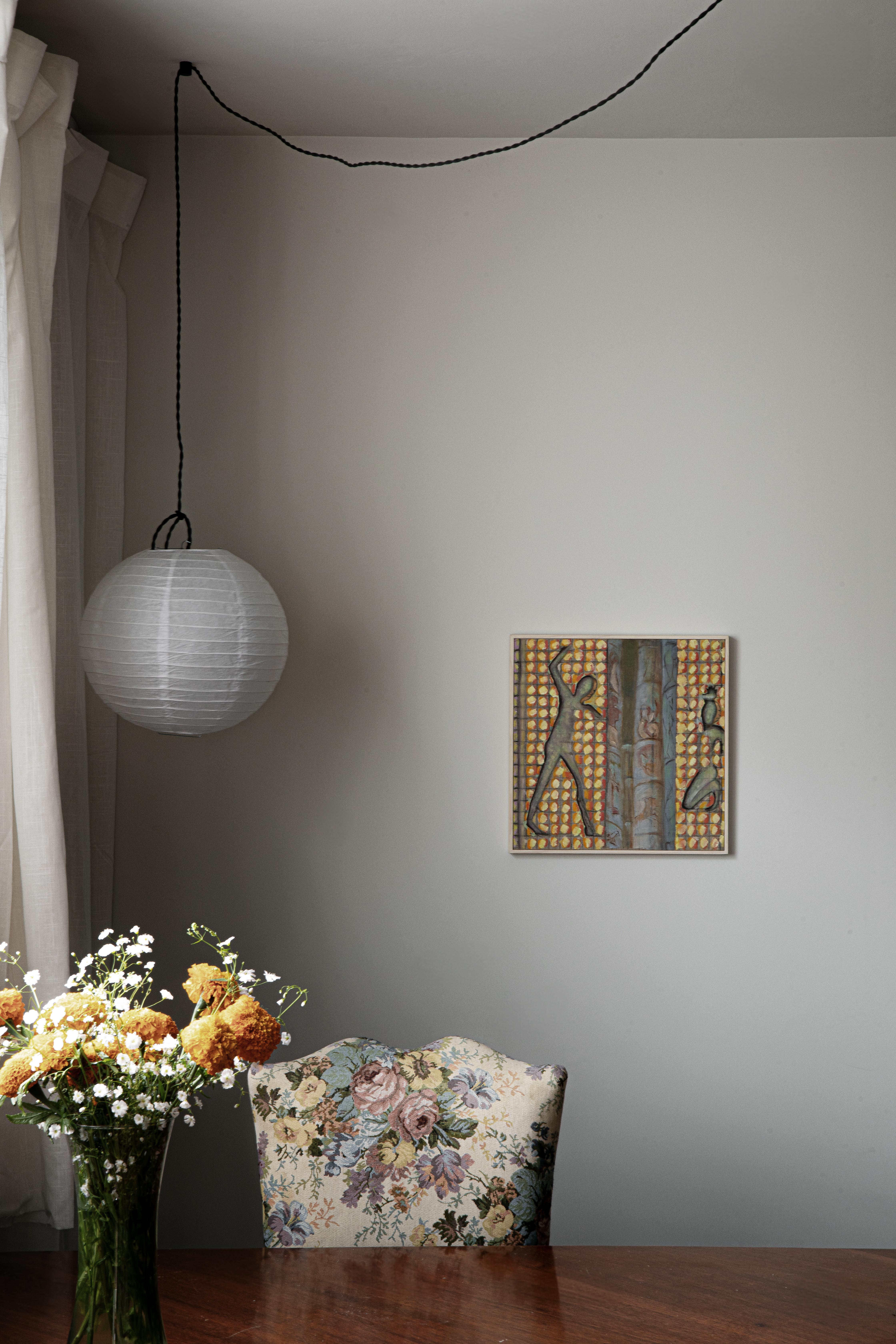Rodrigo Echeverría & Marion Busto: Casa Narciso del Valle
September 21 - November 18, 2023
JO-HS is pleased to present a collaborative project by Rodrigo Echeverría and the architect Marion Busto. Echeverría and Busto recently concluded Casa Narciso del Valle, an architectural project in Colonia del Valle, Mexico City. Rodrigo has created new paintings, drawings, and multimedia works exclusively to be exhibited in the Casa.
This is Rodrigo’s first exhibition with JO-HS since the gallery announced his representation in early October 2023.
The exhibition will be open by appointment only. Email sophie@jo-hs.com to schedule your viewing.
Below, the architect, artist, and educator Andres Souto reflects on Casa Narciso del Valle:
The first observation I can make about this cozy house is the reflection of a unique, distinctive, and challenging fusion of two visions, passions, and individuals. Although art and architecture have always been intertwined in one way or another, I feel that nowadays it is difficult to find projects that address this simple notion in a literal and understandable manner, as the Narciso del Valle house does.
It reminds me of Charles Jencks' description of the double code of postmodern architecture. On the one hand, it manages to speak to the more demanding and knowledgeable audience through the studied and careful use of the architectural elements that compose a building (a house in this case). On the other hand, it creates a deep connection with the "non-expert" user through art and ornamentation. The complex distribution and spatial solution - given that the project is a renovation - complemented by elements such as a portrait of the workers involved in the construction that hangs in the entrance of the house are evidence of a project that consciously or unconsciously, in my opinion, achieves this double code and does so, above all, in a seemingly natural and intuitive manner, at least in appearance. However, the numerous essays and studies of the paintings and frescoes we see in the house, as well as the logs filled with ideas, plans, scribbles, references, and proposals, reveal something hidden beneath the project's lightness. This is the effort, dedication, time, and affection that the couple has invested in this endeavor - clear and beautiful evidence of the passion that Rodrigo and Marion have for their craft.
Casa Narciso del Valle has become a personal reference in architecture for me. Walking through the main door into a beautiful courtyard, being greeted and guided by little lamp creatures makes me feel like I’m in a special place. The details and gestures that unfold along the journey only accentuate this sensation. The use of tiles takes on significant importance when placed on the ceiling of the vestibule - like a water mirror defying gravity - to reflect the delightful colors of the workers’ portrait that welcomes us and provides a moment to rest and reflect before stepping in. Inside, I am struck by the use of white, lightweight, segmented curtains that allow for elegant and versatile control of light. The journey culminates with what Rodrigo calls “our homage to Barragan” a small courtyard enclosed by four high walls that guide our gaze, attention, and time towards the clouds. The masterpiece that is the staircase and the fresco around it overwhelms me. It reminds me, almost as a gentle but serious admonition, that the most important thing in the creative craft - and in life in general - is that it’s okay to play while facing reality’s obstacles.
- Andrés Souto
Leélo en Español︎︎︎
Rodrigo Echeverría (Mexico 1988) is a self-taught painter that, as stated by Nicolas Medina Mora, “follows a very different set of formal laws than those that govern much of contemporary Mexican art. His oeuvre is too diverse and too original to fit comfortably in one or another school and the omnivorous curiosity that nurtures his sensibility could well be described as [that of a] neobarroque painter.” Echeverria began painting from an early age within the context of a conservative and Catholic society. After graduating from university he saw firsthand that the most effective learning happens outside of institutions. As observed by Medina Mora, Echeverría “collect[s] gestures, colors and styles that he then makes his own, not through disrespectful appropriation, but rather by drinking from the countless fountains of human diversity. The fundamental effect that Echeverría’s canvases induce in the viewer is a sort of confusion that proves sometimes joyful, others disquieting, but always productive. Each successive viewing reveals new possibilities, new references, new readings.” His paintings are divided into figurative, portraiture and landscape. He has had important portrait commissions including a portrait of the second room of the Nation’s Supreme Court of Justice and his collectors encompass all levels of society.
More about Rodrigo Echeverría︎︎︎
Marion González Busto is a female architect born and raised in the heart of Mexico City. After studying architecture, she began to develop a series of thoughts around the impact and the value of late 20th century constructions in her city. Her manifest as an architect came from the need to reconfigure and reform these architectures to meet 21st century demands without their demolition and a desire to protect the fabric of the city. Alongside Rodrigo Echeverría, these ideas were put to the test for the first time in a construction site, the result became Casa Narciso del Valle. Her duty as an architect goes beyond the creation and construction, she’s been a teacher in Universidad Iberoamericana and works in a park system investigation project led by Dra. Carolyn Aguilar Dubose and Mtra. Maite García Vedrenne. She’s currently studying her Master’s Degree in Architectural Rehabilitation at the Universidad de Granada.
Andrés Souto is an architect and subject professor in the Department of Architecture of the Universidad Iberoamericana where he has taught the project workshop “Architecture of Popular Culture” since 2017. Souto founded mUcHo studio/workshop in 2017 after completing his master's degree at the Royal College of Art in London. It was there that the focus of his practice was shaped and defined through his research project titled “The Aesthetics of Hope.”
![Installation view, Rodrigo Echeverría & Marion Busto: Casa Narciso del Valle, October 2023, Mexico City. Photos: Alejandro Ramírez Orozco.]()
![Installation view, Rodrigo Echeverría & Marion Busto: Casa Narciso del Valle, October 2023, Mexico City. Photos: Alejandro Ramírez Orozco.]()
![Installation view, Rodrigo Echeverría & Marion Busto: Casa Narciso del Valle, October 2023, Mexico City. Photos: Alejandro Ramírez Orozco.]()
![Installation view, Rodrigo Echeverría & Marion Busto: Casa Narciso del Valle, October 2023, Mexico City. Photos: Alejandro Ramírez Orozco.]()
![Installation view, Rodrigo Echeverría & Marion Busto: Casa Narciso del Valle, October 2023, Mexico City. Photos: Alejandro Ramírez Orozco.]()
![Installation view, Rodrigo Echeverría & Marion Busto: Casa Narciso del Valle, October 2023, Mexico City. Photos: Alejandro Ramírez Orozco.]()
![Installation view, Rodrigo Echeverría & Marion Busto: Casa Narciso del Valle, October 2023, Mexico City. Photos: Alejandro Ramírez Orozco.]()
![Installation view, Rodrigo Echeverría & Marion Busto: Casa Narciso del Valle, October 2023, Mexico City. Photos: Alejandro Ramírez Orozco.]()
![Installation view, Rodrigo Echeverría & Marion Busto: Casa Narciso del Valle, October 2023, Mexico City. Photos: Alejandro Ramírez Orozco.]()
![Installation view, Rodrigo Echeverría & Marion Busto: Casa Narciso del Valle, October 2023, Mexico City. Photos: Alejandro Ramírez Orozco.]() Below, the architect, artist, and educator Andres Souto reflects on Casa Narciso del Valle:
Below, the architect, artist, and educator Andres Souto reflects on Casa Narciso del Valle:![Rodrigo Echeverría, Two Figures, 2023, fresco, 39 3/8 x 39 3/8 in. © Rodrigo Echeverría.]()
![Rodrigo Echeverría, Byzantin corners, 2022, oil on cotton, 7 7/8 x 7 7/8 in. © Rodrigo Echeverría.]()
![Rodrigo Echeverría, The Figure Sliding through Geometry in order to Subjugate, 2023, oil on linen, 15 3/4 x 15 3/4 in. © Rodrigo Echeverría.]()
![Rodrigo Echeverría, A Woman with one arm up, 2023, redimix, watercolor on wood, 11 3/4 x 7 7/8 in. © Rodrigo Echeverría.]()














